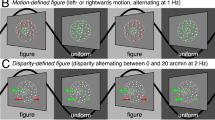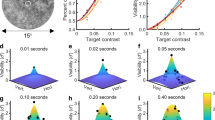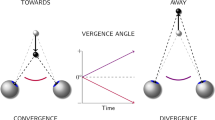Abstract
Objects occlude other objects in natural scenes, and this occlusive relationship increases the spatio-temporal complexity of sensory inputs to the two eyes, especially when objects are moving. We ask whether the visual system can employ clever strategies which make use of real-world constraints on inputs to the eyes to deter-mine the depth of objects. Employing psychophysical methods, we found that occlusion-related geometric rules, which constrain the relationship between the direction of motion and the order and asynchrony of eyes, are implemented at early stages of cortical visual processing.
This is a preview of subscription content, access via your institution
Access options
Subscribe to this journal
Receive 51 print issues and online access
$199.00 per year
only $3.90 per issue
Buy this article
- Purchase on Springer Link
- Instant access to full article PDF
Prices may be subject to local taxes which are calculated during checkout
Similar content being viewed by others
References
Lee, D. Vision Res. 10, 65–78 (1970).
Morgan, M. J. Nature 256, 639–640 (1975).
Burr, D. C. & Ross, J. Vision Res. 19, 523–532 (1979).
Pulfrich, C. Naturewissenschaften 10, 533–564, 569–601, 714–722, 735–743, 751–761 (1922).
Julesz, B. Foundations of Cyclopean Perception (University of Chicago Press, 1971).
Marr, D. & Poggio, T. Proc. R. Soc. B204, 301–328 (1979).
Beverley, K. I. & Regan, D. J. Physiol., Lond. 235, 17–29 (1973).
Ramachandran, V. S. & Cavanagh, P. Nature 317, 527–530 (1985).
Gregory, R. L. & Harris, J. P. Percept. Psychophys. 15, 411–416 (1974).
Rock, I. The Logic of Perception (MIT Press, Cambridge, 1983).
Burkhalter, A. & Van Essen, D. C. J. Neurosci. 6, 2327–2351 (1986).
Maunsell, J. H. R. & Van Essen, D. C. J. Neurophysiol. 49, 1148–1167 (1983).
Hubel, D. H. & Wiesel, T. N. J. Physiol, Lond. 195, 215–243 (1968).
Gardner, J. C., Douglas, R. M. & Cynader, M. S. Brain Res. 328, 154–157 (1985).
Author information
Authors and Affiliations
Rights and permissions
About this article
Cite this article
Shimojo, S., Silverman, G. & Nakayama, K. An occlusion-related mechanism of depth perception based on motion and interocular sequence. Nature 333, 265–268 (1988). https://doi.org/10.1038/333265a0
Received:
Accepted:
Issue Date:
DOI: https://doi.org/10.1038/333265a0
This article is cited by
-
A catch-up illusion arising from a distance-dependent perception bias in judging relative movement
Scientific Reports (2017)
-
A micro-architecture for binocular disparity and ocular dominance in visual cortex
Nature (2009)
-
Neural synchrony correlates with surface segregation rules
Nature (2000)
-
What happens to binocularity in primate strabismus?
Eye (1996)
-
Visual space geometry derived from occlusion axioms
Journal of Mathematical Imaging and Vision (1996)
Comments
By submitting a comment you agree to abide by our Terms and Community Guidelines. If you find something abusive or that does not comply with our terms or guidelines please flag it as inappropriate.



